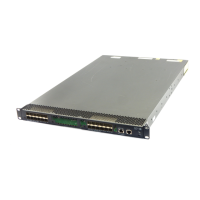59
Field Description
Input/Output
Indicates whether the interface is enabled to receive and send RIP
messages:
• on—Enabled.
• off—Disabled.
Default route
Indicates whether to send a default route to RIP neighbors:
• Only—Advertises only a default route.
• Originate—Advertises both a default route and other routes.
• No-originate—Advertises only non-default routes.
• Off—Advertises no default route.
Default route cost Metric for a default route.
Current number of packets /Maximum
number of packets
Number of RIP packets to be sent/maximum number of RIP packets
that can be sent within a certain interval.
display rip route
Use display rip route to display routing information for a RIP process.
Syntax
display rip process-id route [ ip-address { mask-length | mask } [ verbose ] | peer ip-address | statistics ]
Views
Any view
Predefined user roles
network-admin
network-operator
Parameters
process-id: Specifies a RIP process by its ID in the range of 1 to 65535.
ip-address { mask-length | mask }: Displays route information for the specified IP address.
verbose: Displays all routing information for the specified destination IP address. Without this keyword,
the command displays only information about optimal routes with the specified destination IP address.
peer ip-address: Displays route information learned from the specified neighbor.
statistics: Displays route statistics, including the total number of routes and number of routes from each
neighbor.
Usage guidelines
If no optional parameters are specified, the display rip process-id route command displays all routing
information for a RIP process.
Examples
# Display all routing information for RIP process 1.
<Sysname> display rip 1 route
Route Flags: R – RIP
A - Aging, S - Suppressed, G - Garbage-collect

